Biography
Interests
Ana Nurhasanah1*, Amran Sulaeman2, Andi Nur Alam Syah1 & Athoillah Azadi1
1Indonesian Center for Agricultural Engineering Research and Development, Indonesia
2Indonesian Ministry of Agriculture, Indonesia
*Correspondence to: Dr. Ana Nurhasanah, Indonesian Center for Agricultural Engineering Research and Development, Indonesia.
Copyright © 2019 Dr. Ana Nurhasanah, et al. This is an open access article distributed under the Creative Commons Attribution License, which permits unrestricted use, distribution, and reproduction in any medium, provided the original work is properly cited.
Abstract
Performance of the sorghum polishing machine was performed to determine the performance of the sorghum polishing machine as a whole. The need of polishing the sorghum seed is to reduce the tannin content which is mainly found in the outer skin of the pericarp layers. The high tannin content can reduce the protein digestibility and cause a constipation. Development of a sorghum polishing machine, type of three level of polisher cylinders, was carried out to improve the previous design of polisher. Previously, farmers re-fed the sorghum seeds into the polisher up to three times. This study develop a machine working in a single feed polishing mechanism. Previously in 2012 and 2016, the Indonesian Center for Agricultural Engineering Research and Development, Serpong developed an abrasive type of sorghum polishing machine with a repetitive feeding (up to 4 times), so the working capacity was low varied between 50-100kg/hour. This study aims to modify the polisher machine in order to improve the working capacity. The activities consisted of (i) Development a sorghum seed polisher using a main component of abrasive stone; (ii) Development a three level of polishing mechanism with a single feeding system; (iii) Modification of the screens rotation mechanism working in an opposite direction of the rotation of the abrasive stones. The good quality of the polished seed is shown by the appearance of a full shape and bright color. The performance tests shows that the output capacities were 100-150kg/ hour with tannin content of 0.095% and 3-5% of broken seeds and whiteness of 45.77% with the appearance of whole grain shape and bright color.
Introduction
Sorghum seeds (sorghum bicolor) are known as cereal products that contain carbohydrates and high protein
and are prospective as substitutes for flour and rice. The difficulty in the use of sorghum seeds to be consumed
safely is in terms of removing the tannin content which contained in the pericarp of the seeds. Pericarp of
sorghum seeds blends strongly with the core of the seed (endosperm) which can be consumed safely. The
main way to separate the pericarp with the core of the seed is by polishing (abrasive) [1].
The main function of sorghum polishing is not only to obtain white (bright) from the seeds but also to reduce tannin levels (phenol compounds) which contained in the pericarp layer of seeds. Phenol compounds in tannins when bound with prolamin (kafirin) by forming a bond of the tannin protein complex will reduce protein digestibility in the stomach and cause constipation and bloating. The low content of tannin is generally characterized by the appearance of whitish sorghum rice color which is bright whitish [2].
The condition of low tannin content is an indicator of the readiness of sorghum seeds to be used for various main ingredients of food and feed. For this reason, it is necessary to use a sorghum machine for efficient and effective use. Some sorghum polishing machines currently available are not perfect and still need improvement in the quantity and quality of products.
Improving the performance and quality of results will be done by modifying existing technologies with improvements the systems and components with more appropriate technology and impacting on improved performance and better quality. The polishing quality parameters that will be used include the degree of whiteness, tannin content, the number of sorghum seeds which are damaged/broken and the yield of silting.
Based on these considerations, it is necessary to modify and develop a repeat silo process to be efficient and effective to be done only once in one machine. In addition, the new design process of sorghum polishing stone and material screw carrier to the polishing parts, so that the flow rate of the material can be increased and the stone polishing capacity can be better, and the repetition of polishing becomes one replication. Uniformity of material that will be fooled can increase the efficiency of polishing.
With the result, the development of Sorghum polishing machine needs to be done to complete and finish of research in the previous year. This study aims to obtain the appropriate sorghum shredding machine by modifying the existing machines.
Method
This research is carried out during the period of 1 March to 15 December 2017. The location of planning,
design, machinery manufacturing, functional testing and verification as well as performance testing is
carried out at Engineering Laboratory, BBP Mektan Serpong, whereas laboratory testing is mostly done at
the BB-Pasca, Bogor. The main engineering materials for the manufacture of sorghum polishing machines
include: grinding stone (abrasive stone), diesel engine, blower, iron plate, elbow iron, pulley and belt and
other supporting components. While the test material used is sorghum seeds from varieties KD4, Numbu
and Kawali. The development and modification of the sorghum polishing machine is carried out with the
methods and stages of activities which are divided into: preparation stage, modification and manufacturing
stage, testing phase, and reporting phase. Methodology chart as shown in Figure 1.
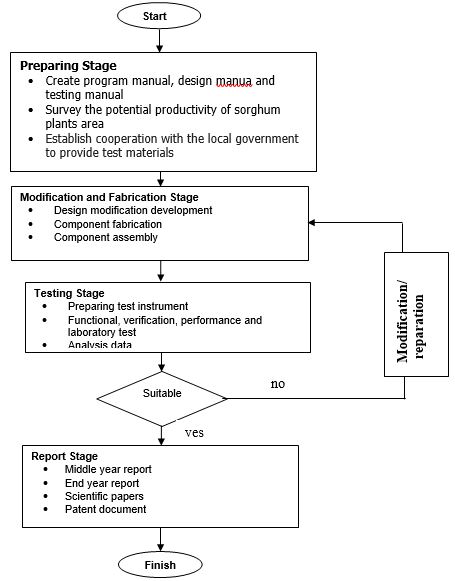
The theoretical work capacity calculation is done by calculating the screw/auger volume that is capable of
carrying sorghum seeds at 850rpm rotation adjusted to the compression ratio of sorghum seeds entering the
polishing chamber and considering the bulk density value.
To increase the polishing capacity, needs greater contact between the seeds and abrasive stones, but on the other hand the increased contact area will increase the temperature in the polishing chamber and the surface temperature of sorghum seeds. This will reduce the capacity at certain times. Therefore, it is necessary to take the displacement between the initial polishing space and the next space, and during the transfer of the material is cooled on the surface of the sorghum seeds. With this design, it is expected that sorghum seeds and polishing chamber will remain in a constant temperature during processing.
Meanwhile, to improve the quality of the results, polishing was carried out 3 times in parallel to increase the capacity of polishing. Sorghum seeds are accommodated in the hopper and enter the polishing chamber and flow from the first to third polish using the gravity method.
Based on the design, sorghum polishing machine consists of several parts: hopper, polishing system, blower, outlet, transmission system, engine, main frame and stairs. Overall the main parts can be seen in Figures 2, 3 and 4.
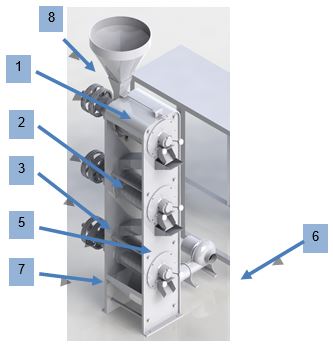
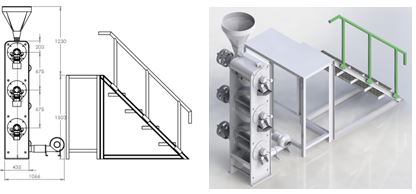
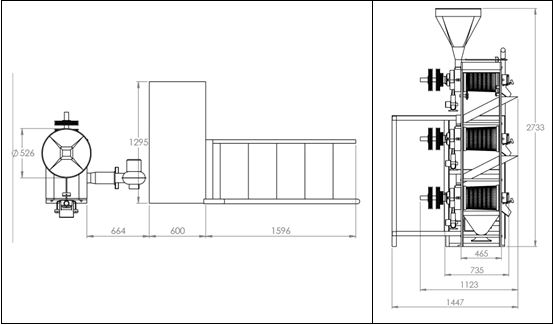
The hopper design is made in the shape of a cone with consideration of the very low cohesion style of
sorghum seeds, so that the material can flow easily into the polishing chamber of using the gravitational
force. The feed process also needs to be regulated by a regulating door to avoid slippage between incoming
seeds so that there is no congestion that causes the engine off or the seeds broken.
In this section, the polisher consists of the abrasive hollow cone stone and completed with a small iron
blower and an auger which serves to channel and push the seeds into the process of polishing. A small
blower functions to exhale the air from the outside into the polishing chamber to push dirt (bran) in the
abrasive stone hole. In addition, the blower also functions to reduce the level of broken seeds caused by the
increase in the temperature of sorghum seeds due to the adhesion and cohesion force. Another part of this
machine is the cylindrical screen, which functions to separate the seeds with dirt or bran. In addition, this
part also serves as a medium / intermediary in the process of cohesion force on the erosion of sorghum skin.
Abrasive stone consists of 3 units installed parallel to increase the quality of the results and increase the
capacity of polishing.
This blower functions to blow out the bran that comes out of the filter cylinder and pushes it out of the
machine.
This section serves as an expenditure polishing seeds equipped with doors that are weighted to provide
moments in the process of polishing. Giving this weight burden affects the time of the process of polishing
that occurs in it.
This part serves as a power distributor that comes from the engine. The sorghum seed polishing machine
transmission system consists of several components, including:
The engine uses a 3 phase electric motor 20kW. Electric motors are chosen as the source of engine because
of their practicality in terms of construction and environmental friendliness and low sound. While the
weakness it is the need for electrical installations.
The frame function serves to support the entire system of polishing machine.
It functions as a tool to help the operator pouring sorghum seeds into the hopper.
Result and Discussion
The overall three-level cylindrical sorghum polishing machine has a dimension of 1350 x 80 x 1350mm with
an electric motor of 20kW. This machine consists of several main components: polishing unit and supporting
components in the form of a frame and engine. This fabricated machinery can be seen in Figure 5.
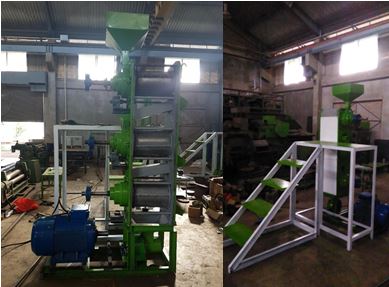
Abrasive stone is a major component in the design of this prototype machine. The abrasive stone used in
this machine is an abrasive stone that has certain shaft dimensions and holes. The abrasive stone for the
prototype machine has a stone diameter of 253mm, a length of 270mm, a shaft diameter 180mm and weight
5kg, produces an optimal polishing capacity with repeated repeats up to 3 times to get sorghum seeds with
tannin content that is safe to consume (<0.5%) as shown in Figure 6.
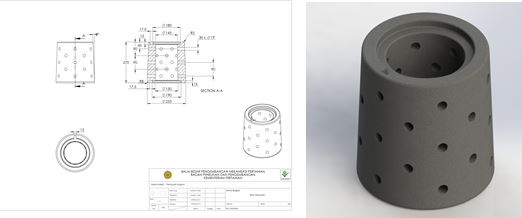
Consideration of the length of the abrasive stone arrangement is based on the length of the contact path between the sorghum and the stone surface so that it does not cause excessive heat to sorghum seeds. The occurrence of excessive heat in the seeds due to the friction between the surface of sorghum and abrasive stones results in gelatinization of sorghum seeds (the surface of the seeds will melt). The gelatinization effect will cause dust /bran stick to the sorghum seeds, on the surface of the stone, and can clog concave filter holes which inhibit the output of dust or bran. The thickness of the stone becomes the durability factor of the pressure received from various directions when the process. According to Mwasaro, et al., 1988, [3] the roughness of abrasive stones used to excavate high tannin sorghum seeds between 24 mesh (diameter 840μm) - 46 (diameter 484μm), while abrasive stones used for polishing machine have mesh 36.
For the process of working the abrasive stone, the center hole of the stone that has a metal wall can be made of a spi hole which serves as a locking stone so that the stone does not move.
Based on the abrasive stone specifications above, the length of the stone required is determined by comparing the length of the path or contact area of the sorghum seeds to the abrasive stone. The wider the contact area will accelerate the process of peeling the skin of the sorghum seeds so that it speeds up the process of polishing. From the calculation results obtained the length of the abrasive stone is needed 240mm which means it takes abrasive stones with specifications above 1 piece, so that the overall abrasive stone length is 270mm.
The theoretical work capacity calculation is done by calculating the screw/auger volume that is capable
of carrying sorghum seeds at 850rpm rotation and the compression ratio of sorghum seeds entering the
polishing room and taking into account the bulk density value. From the results of these calculations obtained
a theoretical capacity of 150.5kg/hour. This value has met the targeted capacity value of 150kg/hour.
Cylindrical screens are made of perforated plates that have a thickness of 1mm with a profile of oblique
rectangular holes (14 x 1.2mm) and a distance between holes of 2mm so that the bran is expected to pass
through the hole. Perforated holes have a slope of 45o against polishing shaft (Figure 7). The cylindrical
screen is designed easier to remove when checking the condition of the stone and other problems that are
likely to occur at the polishing process, without the need to open the casing of the output section.
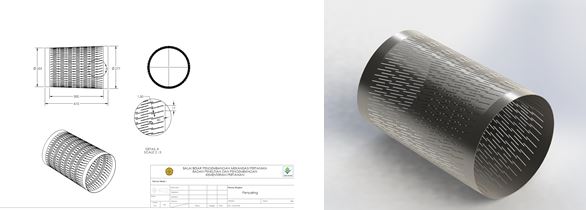
The main frame design is based on a number of things as parameters, including the dimensions and weight
of all components of the polishing unit, the chamber needed by the hopper and consideration of the balance
of the polishing unit when operating in relation to the spinning shaft rotation and vibration. For balance,
the main frame that has a slim and high shape is designed to blend into the engine seat frame, and the
separation unit. To reduce vibration during operation, the lower part of the frame is mounted with bolts
(dynabolt).
The power needs are calculated from the power requirements for the polishing unit. Calculation of engine based on the twisting moment that occurs with the desired engine speed. From the results of the calculation, it was obtained the power for the pilot unit of 20kW.
From the results of the performance test of sorghum polishing machine, the capacity reached is 100 -150kg/
hour. The data of performance test show in table 1 and the polishing seed laboratory test show in table 2.

From the results of the performance test of the sorghum polishing machine, the capacity reached to the first one is 100kg/h (Table 2). This polishing can be done up to two replications with optimum yield quality at 100kg/hour. If the polishing is done continuously above 100kg after two replications than the quality of result of polishing seed becomes decrease. Comparison of the quality of the seed results can be seen in Figure 6. This is due to the bran factor is still out with sorghum seed that causes sorghum that has been completely covered by bran and cause the color becomes not bright.

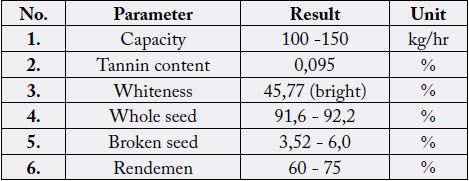
Based on the results of chemical and physical laboratory tests, the sorghum polishing machine is able to reduce the tannin content in accordance with the consumption needs and broken beans 3-6% with maximum discharge 1 time.
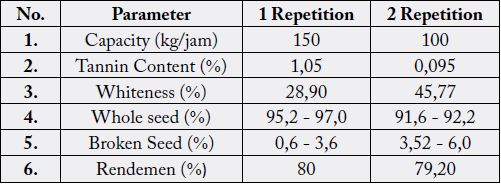
Based on the observations at the performance test, if the test material inserted into the hopper is less than 100kg and twice repetition, the sorghum seeds can be completely dissolved and not mixed with bran (Figure 8a). However, after reaching 100kg above, in the process of polishing the sorghum began to mix with bran (Figure 8b) or about 85% cleanliness level.
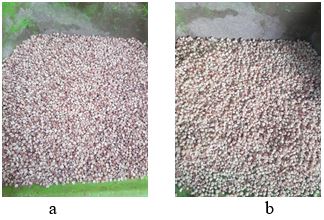
Based on the results of proximate analysis, from several treatments and replications it was found that the fat content and tannin content experienced a significant decrease occurred in the 2 repetition (optimum polishing condition).
The result of proximate analysis can be seen in Table 5.

The result of laboratory analysis of whiteness test obtained an average value of 36.4 - 46.6% (Table 6). This result shows that value of whiteness can decrease in tannin content in the sorghum seed. There is a relationship between the values of whiteness with tannin content, where the higher the value of whiteness the lower the tannin content [4]. Thus the polishing of sorghum seeds twice obtained the value of whiteness and tannin content in accordance with consumption needs.
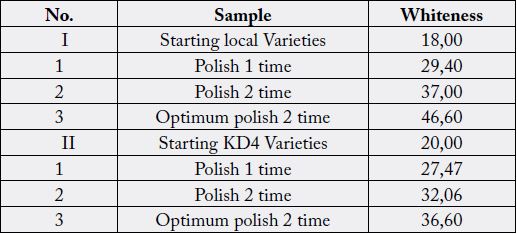
The results of physical analysis of sorghum seeds showed that the process of milling on sorghum seeds can be done well. This can be seen in Table 7 where the percentage of whole seeds averaged 91.16% - 94.40% and seeds broke about 3-6%. This is in accordance with the main objective of polishing is to obtain sorghum seeds with the percentage of seeds broke 3-6%.
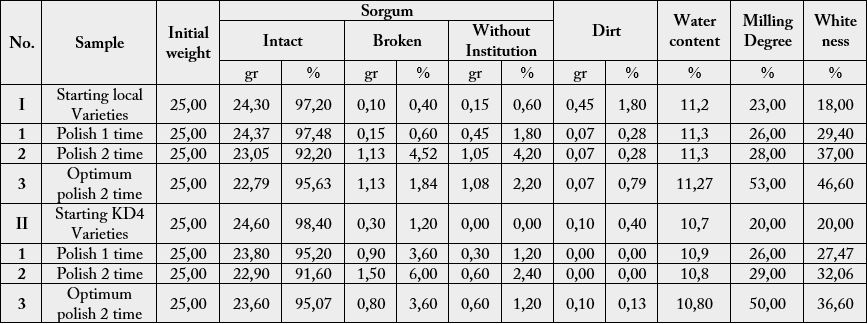
Based on the results of chemical and physical laboratory tests, sorghum polishing machine is able to reduce the tannin content in accordance with the needs of consumption and broken 3-5% seeds with a maximum of 2 polish repetition. But there are some weaknesses in the design of this polishing machine is that if polishing has lasted long and above 100kg, the perfect results is still mixed with bran that come out simultaneously. Various modifications have been made and still continue to be done on the component parts of the absorption unit with the addition of high pressure air blowing unit on the inside of the cylinder that serves to press the bran out the filter [5-10].
Conclusion
The third level sorghum polishing machine consists of main parts: hopper, polishing system, blower, outlet,
transmission system, engine, main frame and stairs. Overall, this machine has been able to polish sorghum
seeds with 1 (one) replication time in one machine so that the capacity of100-150kg/hour with an overall
seed quality of 91.6% - 92,2% and broken seeds around 3-6% and whiteness values 46.66% (bright) with
an average tannin level of 0.095%.
Bibliography

Hi!
We're here to answer your questions!
Send us a message via Whatsapp, and we'll reply the moment we're available!